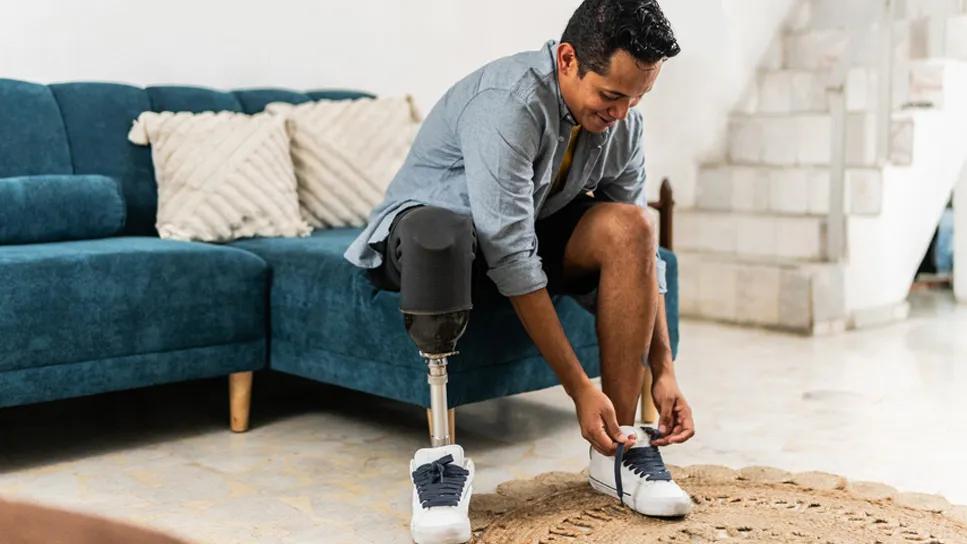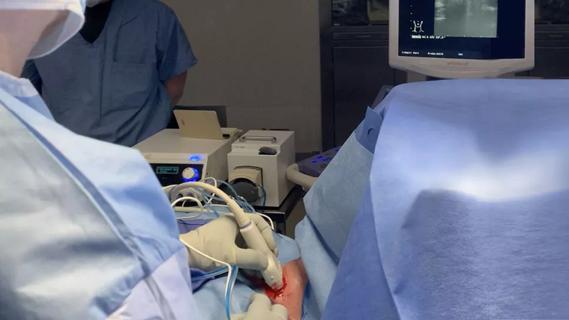Relieves discomfort, reduces opioid dependency and improves quality of life

A self-administered high-frequency nerve block (HFNB) delivered to damaged peripheral nerves provides durable relief of chronic postamputation pain (PAP), reduces use of opioids and improves quality of life (QOL), according to secondary outcomes of a multicenter study led by Cleveland Clinic pain management specialist Nagy Mekhail, MD, PhD.
Advertisement
Cleveland Clinic is a non-profit academic medical center. Advertising on our site helps support our mission. We do not endorse non-Cleveland Clinic products or services. Policy
Published in Neuromodulation, the findings — from the QUEST (high-freQUEncy nerve block for poST amputation pain) trial – suggest that use of HFNB holds promise for long-term treatment of patients with intractable PAP. The data represent 12-month follow-up from the randomized, double-blinded, cross-over study.
“HFNB relieved chronic PAP exacerbations within 30 minutes of application, and the effect lasted for at least two hours. Importantly, over the next six to eight months, the device’s effectiveness with use increased before stabilizing for the remainder of the follow-up period,” says Dr. Mekhail. “These results build on successful primary findings from QUEST and support use of HFNB to relieve pain and quality-of-life burden for patients with lower limb amputations who have chronic PAP.”
Every year in the United States, 160,000 lower limb amputations are performed, and by 2050, estimates indicate that 3.6 million Americans will have undergone such a procedure. For 80% of patients with amputations, pain — in the remaining stump or in the missing “phantom” limb — is chronic and debilitating.
Effective treatment of PAP is challenging because of the multifactorial nature of the mechanisms that underly the condition. Phantom limb pain primarily involves supraspinal mechanisms, whereas neuromas occur via damage to peripheral nerves. Spinal mechanisms of PAP have been linked to functional changes in the dorsal horn of the spinal cord.
Noninvasive, pharmacologic, surgical and neuromodulatory modalities all have been proposed and researched for PAP, with limited success. The QUEST study had its origins in a small feasibility study, which showed that applying high-frequency alternating current directly to damaged peripheral nerves via an implantable, on-demand bioelectric nerve block system reduced pain in patients with amputations. Previously published data from QUEST showed a significantly higher response to HFNB than to active-sham treatment over a three-month period in patients with PAP (24.7% vs. 7.1%; P=0.002).
Advertisement
QUEST enrolled 180 adults with unilateral lower limb amputations ≥12 months who had experienced PAP for at least six months. Pain exacerbations were required to have lasted an hour or more and occurred at least four times per week and scored at least 5 on a numerical rating scale (NRS). Participants also were required to have been on a stable drug regimen for at least four weeks.
Randomization was to active-sham treatment or the investigational Altius Direct Electrical Nerve Stimulation System (Neuros Medical Inc.). The patient-controlled device delivers prespecified treatment via an implantable pulse generator with an integrated rechargeable battery connected to electrodes around the target nerves. After the three-month randomization period, control subjects in QUEST were crossed over to active treatment for the remainder of the 12-month study.
The current report represents long-term, single-cross-over, secondary outcomes of on-demand HFNB in QUEST. Of the 180 original study participants, 164 participated in the cross-over period and 146 completed follow-up.
In the combined cohort, by month 12, NRS pain 30 minutes after HFNB treatment was reduced by an average of 2.3 ± 2.2 points, and at 120 minutes after treatment, the average reduction was 2.9 ± 2.4 points (both P<0.0001). Mean pain days also were significantly reduced (-3.5 ± 2.7 days; P<0.001).
From baseline to month 12, daily opioid use was reduced by 6.7 ± 29.0 morphine equivalent dose (P=0.013). During the same period, QOL scores, as measured by mean BPI-interference scores, improved by 2.7 ± 2.7 points (P<0.001).
Advertisement
Says Dr. Mekhail, “Clinically meaningful reductions from baseline in self-reported daily pain levels were sustained through 12 months, indicating lasting changes in overall pain profiles. In addition, participants had a nearly 50% improvement in QOL, with a significant reduction in opioid mediation usage from baseline.”
Nonserious and serious adverse events (AEs) were seen in 72% and 42% of participants, respectively. Eight percent of participants had serious device-related AEs.
Because the HFNB delivers an HFAC waveform that blocks pain signals in the periphery from reaching the central nervous system, Dr. Mekhail says, the QUEST results underscore the importance of reducing aberrant peripheral activity to effectively treat PAP exacerbations.
Limitations of the study include the single cross-over design, lack of control for use of pain medication between groups, exclusion of individuals with uncontrolled diabetes and lack of differentiation of pain type.
Nevertheless, notes Dr. Mekhail, “this is the first documentation, to our knowledge, of a therapy that can effectively and reproducibly block acute pain while also decreasing chronic PAP. Moreover, the low rates of device-related AEs suggest a favorable safety profile in a population that has a substantial incidence of diabetes mellitus and peripheral vascular disease.”
Advertisement
Advertisement

Add AI to the list of tools expected to advance care for pain patients

Cleveland Clinic study investigated standard regimen

Despite the condition’s debilitating, electric shock-like pain, treatment options are better than ever

Tapping into motivational interviewing to guide behavioral change

Self-efficacy mindset, burst therapy and increased biofeedback may help improve outcomes

Radiofrequency ablation significantly reduces symptom severity, shrinks nodules

Novel research to evaluate noninvasive treatments in ED and chronic pelvic pain

6 objective measures to assess pain and evaluate progress